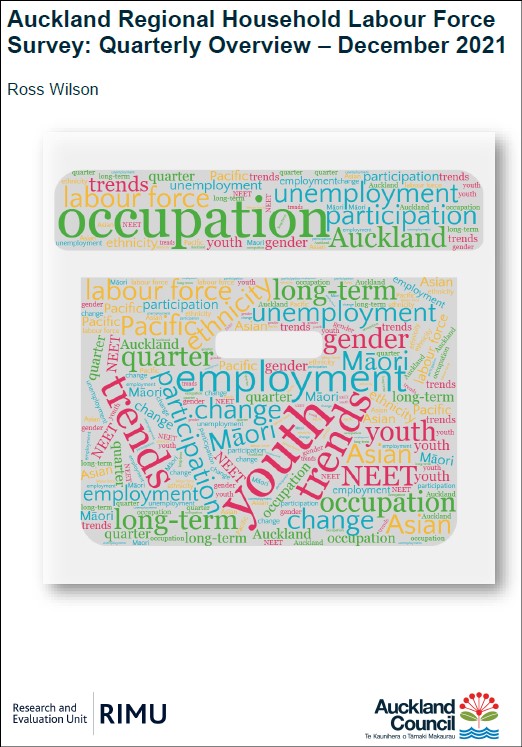Auckland regional household labour force survey: quarterly overview December 2021
Author:
Ross WilsonSource:
Auckland Council Research and Evaluation Unit, RIMU | Statistics New ZealandPublication date:
2022Topics:
EconomyAn overview of labour force participation in Auckland, as indicated by results of Stats NZ's quarterly Household Labour Force Survey. HLFS
Overview and highlights
For the December 2021 quarter, compared to the preceding quarter (not seasonally adjusted):
- Auckland’s unemployment rate was at 3.0%, similar to 3.1% at September 2021. This is the lowest recorded rate of unemployment since 2007.
- The number of people unemployed (29,400) was similar to September 2021 (30,900).
- The number of people employed (955,900) was also similar (slight decrease of 2200 or 0.2%).
- There was a slight rise in the number of people not in the labour force (NILF) (increase of 3600 to 382,600).
- The labour force participation rate (72.0%) was similar to September (72.3%).
- Average weekly hours worked was 37.8 (including full and part-timers), and the gap (5.6 hours) between males (40.5) and females (34.9) was the lowest ever recorded.
- The rate of young people aged 15 to 24 not in employment, education or training (NEET) was 10.7%, similar to September (10.6%) and to the rest of New Zealand (11.6%).
Over the year ended December 2021, compared to the year ended December 2020:
- The unemployment rate averaged 3.9%, compared to 4.9% in the 12 months to December 2020 – constituting a reduction of one fifth.
- The unemployment rate for those aged 20 to 24 averaged 7.7%, a quarter less than a year prior (10.5%).
- The unemployment rate for females of all ages averaged 3.9%, nearly a third lower than 5.4% a year prior. The rate for males averaged 3.8% (down from 4.5% a year prior), so the gap between males and females is currently minimal (0.1%).
- The unemployment rate for Pacific people (7.7%) was similar to the year before (8.1%). Rates for other main ethnic groups decreased by about a quarter: Māori (6.6%, down from 8.4%), Asian (3.8%, down from 5.4%) and European (2.9%, down from 3.7%).
- The labour force participation rate averaged 71.6%, slightly above 2020 (70.0%).
- The labour force participation rates for females (66.3%) and males (77.0%) were slightly above a year prior (64.6% and 75.7% respectively).
- Labour force participation rates rose slightly from a year prior for all ages, especially 15-19 (41.1% from 39.2%) and 20-24 (78.4% from 75.5%).
- Labour force participation rates were slightly above a year prior for European (72.7%), Māori (67.3%) and Pacific (63.4%) ethnicities, and more for Asian (75.0%).
Overview published February 2022.
